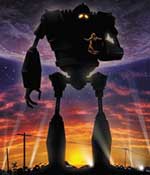
by Tim Law and Luis Reyes
Back in February, Akadot visited with the head of Warner Brothers Animation, Ken Duer, who reminisced about the past and speculated about the future of America's feature animation industry. With the ten-year animation boom behind us, it's only a matter of time before things start to heat up again, but tepid offerings like Disney's "Atlantis" and Warner Brothers' "Osmosis Jones" may keep animation in its cryogenic freeze a while longer. Driven by a strong desire to work more closely with trans-Pacific animation houses and fueled with the experience to back it up, Ken Duer knows where the industry might be headed. Considering the critical accolades and the strong video showing, what do you feel is the reason that "Iron Giant" didn't do better? Ken Duer: There are different reasons, but one of the most common things talked about is that Warner Brothers did not market the film at all. In a way that's true because we really didn't see much in the way of marketing - advertising on television; in print media; online. But at the same time we also know that in England it was advertised well, marketed well, but still didn't do well. It's really a difficult case. People ask, "Okay then, what was it?" and nobody really seems to answer that question. Hopefully we have learned from the mistake on "Iron Giant." Getting ready to release "Osmosis Jones" this summer, we're counting that this will be the catalyst for re-doing the entire Warner Brothers animation business. What does the future hold for Warner Brothers' feature animation division after "Osmosis Jones?" KD: There are a couple of projects being developed and waiting to be greenlit. I think the studio wants to go back to utilizing the classic "Looney Tunes" characters rather developing original concepts with original characters. Since "Space Jam" was such a hit there are a couple developments on that side. So they want to stay close to the franchise that everybody knows? KD: Yeah, that seems to be the general trend in the industry right now. The so-called animation bubble of the last ten years popped around two years ago and the industry has been declining steadily ever since. Everybody's backing off from experimenting with new materials. Everybody's going back to turning the materials that they've always had into new shows or actually taking live action family entertainment ideas and turning them into animated series. Can you name anything specific? KD: Actually when you look at the slate of Sony's TV production, they've always had that business model. They turned "Starship Troopers" into a TV series, "Men in Black," "Jumanji;" they've approached the whole business a little differently. And I think that both Warner Brothers and Disney are following. Let's take Disney, all the video material they've been putting out has been nothing but "Lion King 2 and 3." They just finished "Lady and the Tramp 2." They're regenerating the same materials and redoing them for a new market. So the industry as a whole is afraid to take risks? KD: I think so. Do you remember a time when success came out of studios taking more risks? KD: Up until around two years ago, the industry was doing so well that there was no end in sight in terms of success. As a result, a lot of money was being thrown around for animation, both television and features. Dreamworks, MGM, Fox - you name it, everybody had their animation entity. At that time Fox tried "Titan A.E." because people were getting tired of the Disney formula and they wanted to see something a bit more edgy, something different. Fox decided to explore sci-fi, learning from the Japanese, if you will - taking a step away from the animated Broadway formula that Disney had exploited for the past ten years. But again, for whatever the reasons, "Titan A.E." bombed and Fox closed their whole animation division. Dreamworks, the same thing; they closed their TV entity. But during that time people were experimenting and taking risks. When you look further back, the days of "Ren and Stimpy" were successful. The nineties were full of experimental projects that would never even be tried now. Now, everybody's back to the basics, especially with the features where you're talking about forty, fifty, sixty - or even more - millions of dollars. And when it flops, it flops big time.
Is the cycle of experimenting and then withdrawing common in the animation industry? KD: It is common. In the mid eighties, shortly after I started in the animation industry, there was a huge lull in the business. That's when Hanna-Barbera started sending all their animation overseas. There was a studio called Filmation back then, a pretty big studio, and they closed their doors. Disney was working on "The Black Cauldron," an experiment for them, and that was a huge disaster. People stayed away from animation. What initiated the resurgence was the release of "Who Framed Roger Rabbit?" That was something out of the ordinary. It was a very good mixture of live action and animation and it was very well done. Everybody jumped on to the animation bandwagon again and it continued for ten years. That's when Warner Brothers started their studios again, releasing "Tiny Toons" in '88. Shortly before that, Disney started their TV division. Because there was a lot of money and a lot of different ideas, new talents were coming in and people were willing to take the risks. Some failed, some made it. That era is over and now we're back to what we were seeing in the mid eighties. But somebody out there is going to be the one to break the rules again and do something extraordinary, and everyone is going to jump on the animation bandwagon again. It's different every time the cycle hits. And it's different because now we have the internet and cable television to deal with as well as the direct to video market - in the eighties there were only three networks: NBC, ABC, and CBS. The only substantial player in the feature arena was Disney, who has always had a lion's share of the market. Where do you see Disney loosing its grip, if at all? KD: They definitely are losing their grip and probably realize it. That's why they're starting to develop different types of features, "Atlantis" for example. I even thought "Tarzan" was different. There weren't as many songs - I think they finally realized that people were tired of a character breaking into song every five minutes to tell the story. Personally, that's why I stopped watching Disney after "Pocahontas." But then "Tarzan," they developed with this incredible software with which to treat the backgrounds for when he flew through the jungle, so I went to see that and thought, "Oh, it is a little different." "Mulan" was treated differently, so I think in a subtle sense they are trying different areas. I know that they've been developing - I forget the title - a "Treasure Island" in space. They're especially concerned about Japanese animation coming. They know that they're loosing their grip and they're pretty desperate to take control again. If anything, I think "Iron Giant" told its story more like an anime than a Disney film. What seemed to really launch the Disney Broadway formula was the "Little Mermaid." KD: Jeffrey Katzenberg tried that out, and it proved successful for the next four or five pictures. Then he found out that the CDs were selling incredibly well, so they re-established their own formula. But people get tired of the same formula over and over. |
||||||||


